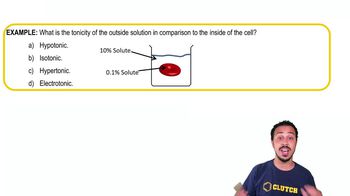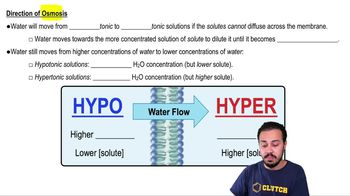Table of contents
- 1. Introduction to Biology2h 42m
- 2. Chemistry3h 40m
- 3. Water1h 26m
- 4. Biomolecules2h 23m
- 5. Cell Components2h 26m
- 6. The Membrane2h 31m
- 7. Energy and Metabolism2h 0m
- 8. Respiration2h 40m
- 9. Photosynthesis2h 49m
- 10. Cell Signaling59m
- 11. Cell Division2h 47m
- 12. Meiosis2h 0m
- 13. Mendelian Genetics4h 44m
- Introduction to Mendel's Experiments7m
- Genotype vs. Phenotype17m
- Punnett Squares13m
- Mendel's Experiments26m
- Mendel's Laws18m
- Monohybrid Crosses19m
- Test Crosses14m
- Dihybrid Crosses20m
- Punnett Square Probability26m
- Incomplete Dominance vs. Codominance20m
- Epistasis7m
- Non-Mendelian Genetics12m
- Pedigrees6m
- Autosomal Inheritance21m
- Sex-Linked Inheritance43m
- X-Inactivation9m
- 14. DNA Synthesis2h 27m
- 15. Gene Expression3h 20m
- 16. Regulation of Expression3h 31m
- Introduction to Regulation of Gene Expression13m
- Prokaryotic Gene Regulation via Operons27m
- The Lac Operon21m
- Glucose's Impact on Lac Operon25m
- The Trp Operon20m
- Review of the Lac Operon & Trp Operon11m
- Introduction to Eukaryotic Gene Regulation9m
- Eukaryotic Chromatin Modifications16m
- Eukaryotic Transcriptional Control22m
- Eukaryotic Post-Transcriptional Regulation28m
- Eukaryotic Post-Translational Regulation13m
- 17. Viruses37m
- 18. Biotechnology2h 58m
- 19. Genomics17m
- 20. Development1h 5m
- 21. Evolution3h 1m
- 22. Evolution of Populations3h 52m
- 23. Speciation1h 37m
- 24. History of Life on Earth2h 6m
- 25. Phylogeny2h 31m
- 26. Prokaryotes4h 59m
- 27. Protists1h 12m
- 28. Plants1h 22m
- 29. Fungi36m
- 30. Overview of Animals34m
- 31. Invertebrates1h 2m
- 32. Vertebrates50m
- 33. Plant Anatomy1h 3m
- 34. Vascular Plant Transport1h 2m
- 35. Soil37m
- 36. Plant Reproduction47m
- 37. Plant Sensation and Response1h 9m
- 38. Animal Form and Function1h 19m
- 39. Digestive System1h 10m
- 40. Circulatory System1h 57m
- 41. Immune System1h 12m
- 42. Osmoregulation and Excretion50m
- 43. Endocrine System1h 4m
- 44. Animal Reproduction1h 2m
- 45. Nervous System1h 55m
- 46. Sensory Systems46m
- 47. Muscle Systems23m
- 48. Ecology3h 11m
- Introduction to Ecology20m
- Biogeography14m
- Earth's Climate Patterns50m
- Introduction to Terrestrial Biomes10m
- Terrestrial Biomes: Near Equator13m
- Terrestrial Biomes: Temperate Regions10m
- Terrestrial Biomes: Northern Regions15m
- Introduction to Aquatic Biomes27m
- Freshwater Aquatic Biomes14m
- Marine Aquatic Biomes13m
- 49. Animal Behavior28m
- 50. Population Ecology3h 41m
- Introduction to Population Ecology28m
- Population Sampling Methods23m
- Life History12m
- Population Demography17m
- Factors Limiting Population Growth14m
- Introduction to Population Growth Models22m
- Linear Population Growth6m
- Exponential Population Growth29m
- Logistic Population Growth32m
- r/K Selection10m
- The Human Population22m
- 51. Community Ecology2h 46m
- Introduction to Community Ecology2m
- Introduction to Community Interactions9m
- Community Interactions: Competition (-/-)38m
- Community Interactions: Exploitation (+/-)23m
- Community Interactions: Mutualism (+/+) & Commensalism (+/0)9m
- Community Structure35m
- Community Dynamics26m
- Geographic Impact on Communities21m
- 52. Ecosystems2h 36m
- 53. Conservation Biology24m
6. The Membrane
Osmosis
Problem 8`
Textbook Question
A cell that is placed in salty seawater will ________.
a. Take sodium and chloride ions in by diffusion.
b. Move water out of the cell by active transport.
c. Use facilitated diffusion to break apart the sodium and chloride ions.
d. Lose water to the outside of the cell via osmosis.
 Verified step by step guidance
Verified step by step guidance1
Understand the concept of osmosis: Osmosis is the movement of water molecules across a semipermeable membrane from an area of lower solute concentration to an area of higher solute concentration, aiming to equalize solute concentrations on both sides of the membrane.
Analyze the environment: Salty seawater has a higher solute concentration (salt) compared to the inside of the cell, making it a hypertonic solution relative to the cell's internal environment.
Determine the direction of water movement: In a hypertonic solution, water will move out of the cell to the area of higher solute concentration (the seawater) through osmosis.
Eliminate incorrect options: a) Diffusion of sodium and chloride ions into the cell is unlikely because the cell membrane typically restricts ion movement without specific transport mechanisms. b) Active transport of water out of the cell does not occur because water movement in osmosis is passive. c) Facilitated diffusion does not involve breaking apart ions; it involves the transport of molecules across the membrane with the help of proteins.
Conclude the correct answer: The cell will lose water to the outside environment via osmosis, as water moves out to balance the solute concentration difference.
 Verified video answer for a similar problem:
Verified video answer for a similar problem:This video solution was recommended by our tutors as helpful for the problem above
Video duration:
3mPlay a video:
Was this helpful?
Key Concepts
Here are the essential concepts you must grasp in order to answer the question correctly.
Osmosis
Osmosis is the movement of water molecules across a selectively permeable membrane from an area of lower solute concentration to an area of higher solute concentration. In the context of a cell in salty seawater, water will move out of the cell to balance the higher concentration of solutes (salt) outside, leading to cell shrinkage.
Recommended video:
Guided course

Osmosis
Diffusion
Diffusion is the process by which molecules spread from areas of high concentration to areas of low concentration. In the case of a cell in seawater, sodium and chloride ions may diffuse into the cell if the concentration inside is lower, but this is less relevant when considering the overall osmotic effect of the salty environment.
Recommended video:
Guided course

Diffusion
Active Transport
Active transport is the movement of ions or molecules across a cell membrane against their concentration gradient, requiring energy, usually in the form of ATP. While cells can use active transport to maintain ion balance, in the scenario of salty seawater, the primary concern is the passive loss of water through osmosis rather than the active uptake of ions.
Recommended video:
Guided course

Active Transport
Related Videos
Related Practice














